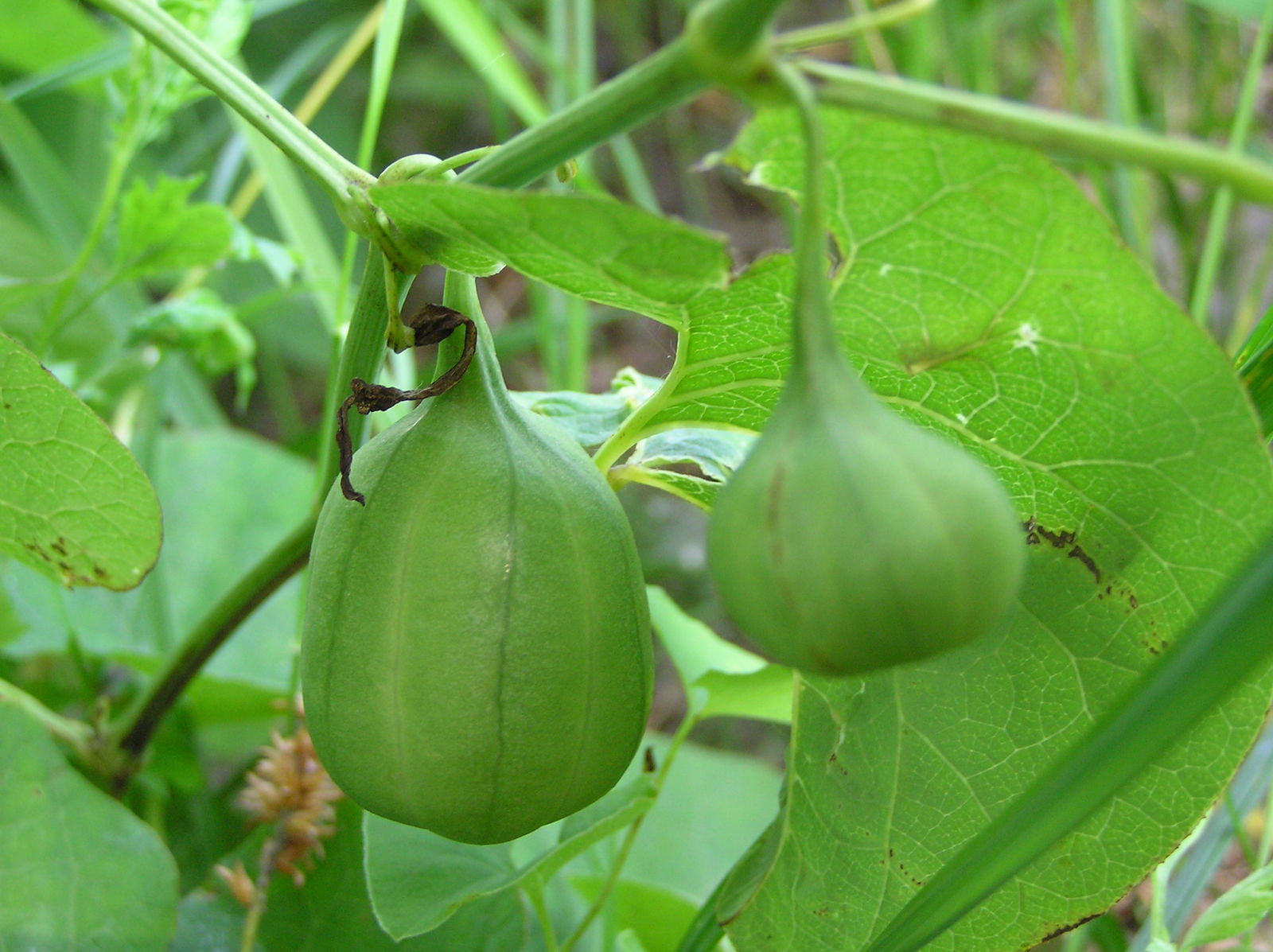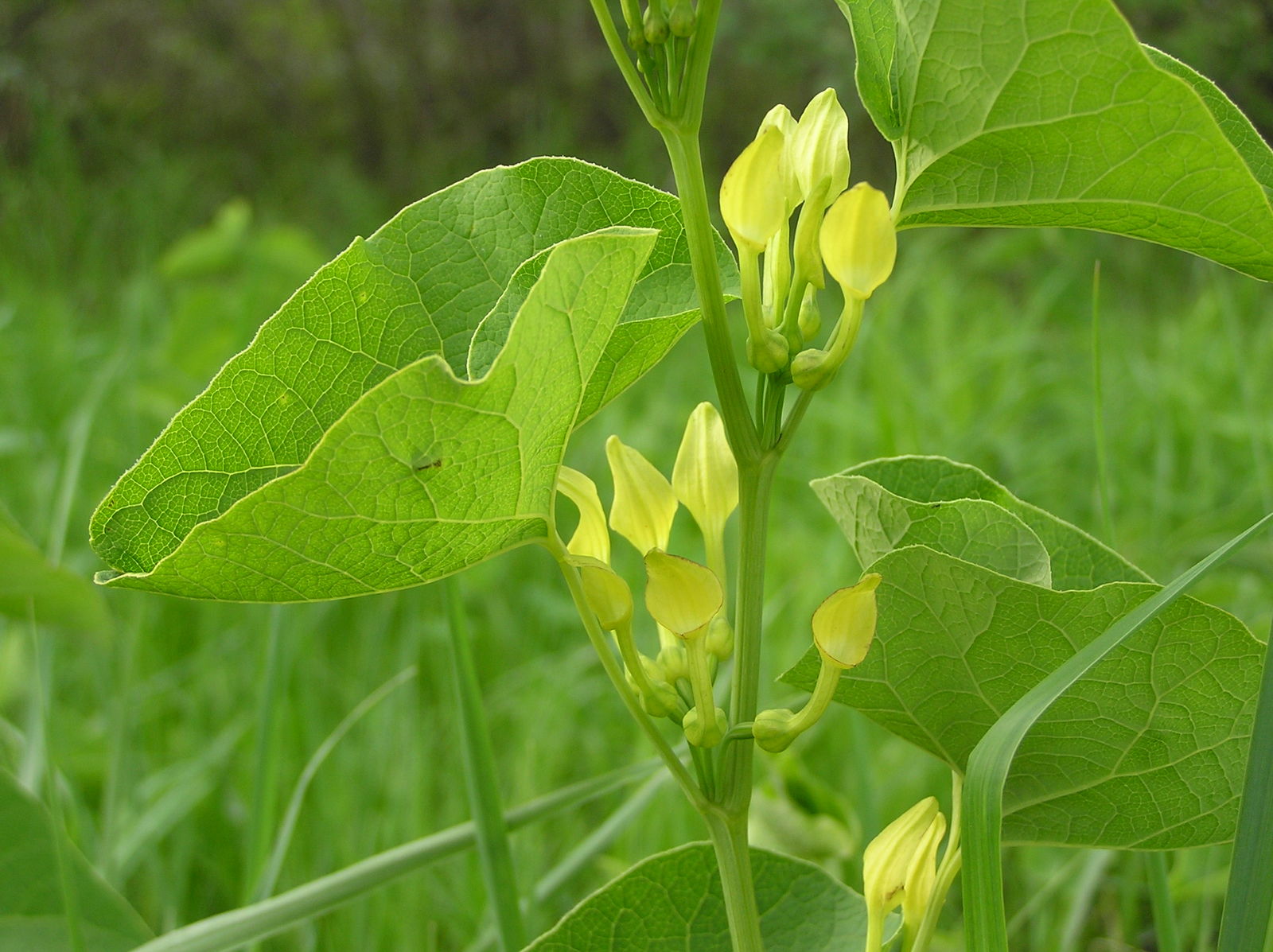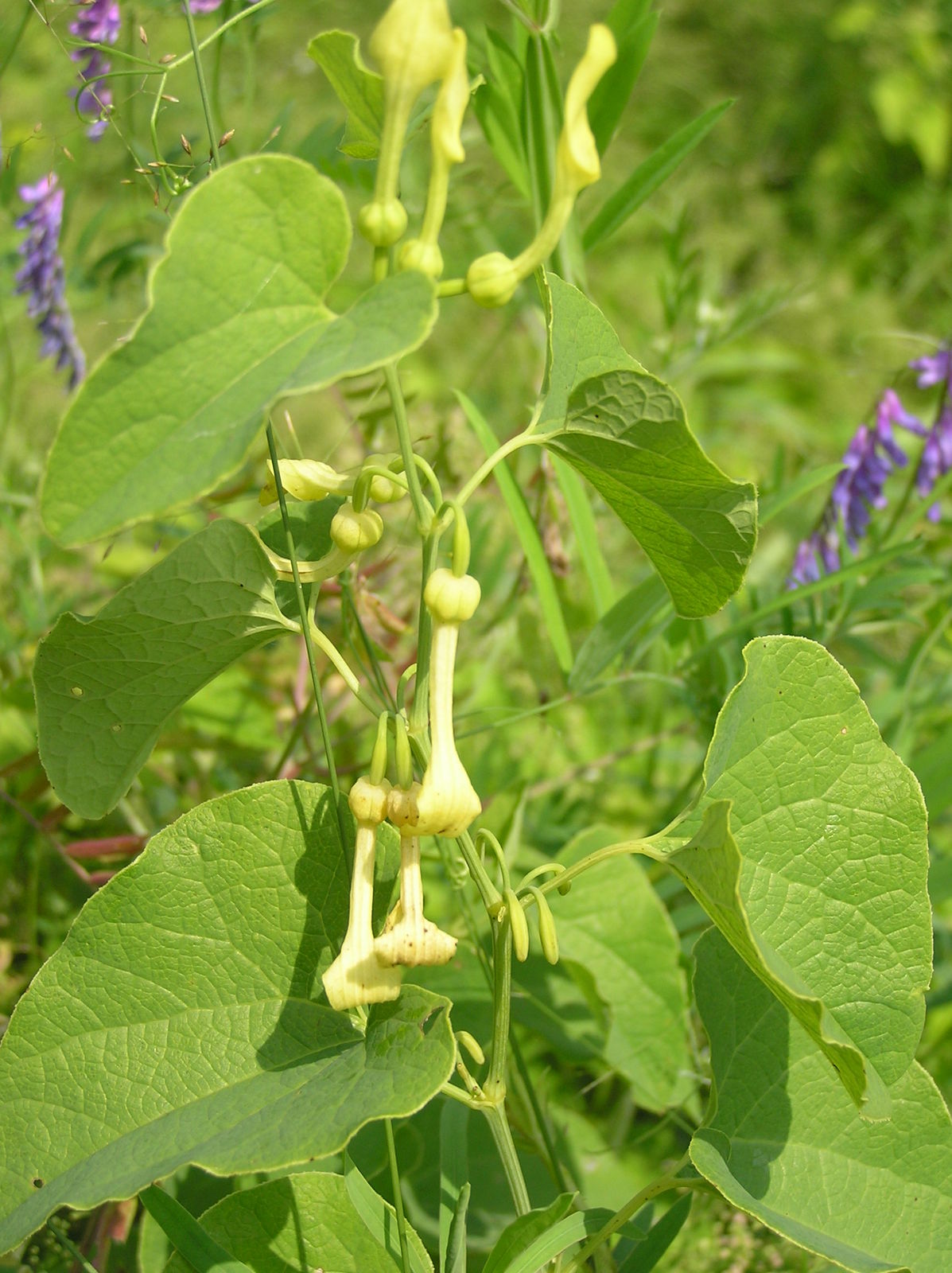Family: Aristolochiaceae
Author: L.
Bibliography: Sp. Pl.: 962 (1753)
Year: 1753
Status: accepted
Rank: species
Genus: Aristolochia
Vegetable: False
Observations: Europe to Caucasus
Description
Birthwort, scientifically known as Aristolochia clematitis, is a perennial plant famed for its historical and medicinal significance, dating back to ancient times. With an initial mention in Carl Linnaeus’s seminal work “Species Plantarum” in 1753, this plant has been recognized across various regions in Europe extending to the Caucasus.
Belonging to the Aristolochiaceae family, Birthwort stands out for its unique characteristics. The plant features heart-shaped leaves and distinctively shaped flowers that resemble a curved pipe, a form known as “gaping,” which some suggest is the reason behind its common name. These yellow-greenish blossoms typically appear from May to October, attracting a unique spectrum of pollinators due to their unusual morphology and scent.
Indigenous to a range of environments, Birthwort thrives in both grassy and woodland settings, adapting well to different soil types. Its robust nature allows it to spread easily, often forming dense clusters that can become quite prominent in a given area.
Historically, Birthwort was prized in traditional medicine. The genus name, Aristolochia, derives from the Greek words ‘aristos’ (best) and ‘locheia’ (childbirth), reflecting its long-standing use in aiding labor and delivery. However, modern science has identified that compounds within the plant, specifically aristolochic acids, can be highly toxic and carcinogenic, leading to significant caution in its handling and application today. Despite these dangers, Birthwort’s allure persists, primarily because of its distinctive appearance and historical significance.
Beyond its historical applications, Birthwort is also of particular interest to botanists and ecologists. It serves as a host plant for certain species of butterflies, such as the Swallowtail, playing a critical role in local ecosystems. Its interaction with pollinators and symbiotic relationships within its habitat offer a fascinating glimpse into the complexities of plant ecology.
In conclusion, Aristolochia clematitis, or Birthwort, is a plant of considerable interest not only for its distinctive botanical features and its storied past in medicinal lore but also for its ecological significance. While modern usage is limited due to its toxic properties, the plant continues to captivate those who study it, offering insights into the delicate balance of nature and the enduring impact of traditional botanical knowledge.
Common Names
Eng: birthwort, heartwort
Fin: etelännenätti, keltasinappi, rikkanenätti
Deu: gewöhnliche osterluzei, wolfskraut, gemeine osterluzei
Dan: gul sennep, hjertebladet slangerod, slangerod, vej-guldkarse, østrigsk guldkarse
Swe: klotfräne, strandfräne, vitsenap, vägfräne, hålrot, pipranka
Nor: kulekarse, kvitsennep, vegkarse
Lit: paprastoji kartuolė
Fra: aristoloche, aristoloche clématite, sarrasine
Nno: holurt
Lav: mežvīteņu aristolochija, mežvīteņu aristolohija
Nld: pijpbloem
Nob: pipeurt
Cym: afal daear, esgorllys bychan, esgorllys crwn, esgorlys, henllydan
En: Birthwort, Heartwort, European birthwort
Ab: Аҩсҭааҟәыд
Ar: زراوند ظياني
Az: Adi zəravənd, Ağəsməyəbənzər zəravənd
Be: Кірказон павойнікападобны
Bg: Обикновена вълча ябълка
Ca: Aristolòquia sarmentosa, Llengua viperina
Zh: 欧洲马兜铃, 铁线莲状马兜铃
Hr: Žuta vučja stopa
Cs: Podražec křovištní
Da: Hjertebladet Slangerod, Gul Sennep, Slangerod, Vej-Guldkarse, Østrigsk Guldkarse
Nl: Pijpbloem
Eo: Kutima aristolokio
Et: Elulõngjas tobiväät
Fi: Herttapiippuköynnös, Piippuruoho, Herttapiippuruoho, Etelännenätti, Keltasinappi, Rikkanenätti
Fr: Aristoloche clématite, Sarrasine, Aristoloche clematite, Aristoloche, Fanterne, Pipe, Poison-de-terre, Pomerasse, Ratelaine, Poison de terre
De: Wolfskraut, Gemeine Osterluzei, Gewöhnliche Osterluzei, Osterluzei
Hu: Közönséges farkasalma
It: Aristolochia clematite, Erba astrologa
Kk: Жиренше
Lv: Mežvīteņu aristolochija, Mežvīteņu aristolohija
Lt: Paprastoji kartuolė
Mk: Волчје јаболко
Gv: Cleaysh vuc
No: Kulekarse, Kvitsennep, Vegkarse
Nb: Pipeurt
Nn: Holurt
Pl: Kokornak powojnikowaty, Kokornak powojnikowy, Kokornak powojowaty
Pt: Aristolóquia
Ro: Mărul lupului
Ru: Кирказон ломоносовидный, Кирказон обыкновенный
Sr: Вучја јабука
Sk: Vlkovec obyčajný
Es: Aristoloquia, Aristoloquia común, Aristoloquia sarmentosa, Aristoloquia vulgar, Aristolòquia sarmentosa, Clematitide, Clematítide, Cornamusa enredada, Aristoloquia clematidea
Sv: Hålrot, Klotfräne, Strandfräne, Vitsenap, Vägfräne, Pipranka
Zh-tw: 歐洲催生草
Uk: Хвилівник звичайний
Cy: Esgorlys, Afal Daear, Esgorllys Bychan, Esgorllys Crwn, Henllydan
Synonyms
- Aristolochia longa (Georgi)
- Aristolochia quadriflora (Gueldenst.)
- Aristolochia infesta (Salisb.)
- Aristolochia tenuis (Houtt.)
- Aristolochia clematitis f. undulata (Priszter)
Distribution
- Albania (native)
- Austria (native)
- Baleares (native)
- Baltic States (native)
- Belarus (native)
- Belgium (native)
- Bulgaria (native)
- Central European Rus (native)
- Corse (native)
- Czechoslovakia (native)
- East European Russia (native)
- France (native)
- Germany (native)
- Greece (native)
- Hungary (native)
- Italy (native)
- Kazakhstan (native)
- Krym (native)
- Netherlands (native)
- North Caucasus (native)
- Northwest European R (native)
- Poland (native)
- Romania (native)
- Sicilia (native)
- South European Russi (native)
- Spain (native)
- Switzerland (native)
- Transcaucasus (native)
- Turkey (native)
- Turkey-in-Europe (native)
- Ukraine (native)
- Yugoslavia (native)
- Denmark (introduced)
- Great Britain (introduced)
- Maryland (introduced)
- Masachusettes (introduced)
- New York (introduced)
- Norway (introduced)
- Ohio (introduced)
- Ontario (introduced)
- Pennsylvania (introduced)
- Québec (introduced)
- Sweden (introduced)
Additional Images

© copyright of the Board of Trustees of the Royal Botanic Gardens, Kew.

© copyright of the Board of Trustees of the Royal Botanic Gardens, Kew.

© copyright of the Board of Trustees of the Royal Botanic Gardens, Kew.
Leaf
Taken Jan 15, 2022 by Varrey Daniel (cc-by-sa)
Taken May 21, 2020 by Hüseyin Tuncay (cc-by-sa)
Taken May 21, 2021 by Claire Perrachon (cc-by-sa)
Taken May 18, 2020 by Cyrille Gaultier (cc-by-sa)
Taken Jun 9, 2019 by barra Walter (cc-by-sa)
Fruit
Taken Nov 3, 2016 by Yoan MARTIN (cc-by-sa)
Taken Oct 14, 2021 by Jean-Yves DEBBIA (cc-by-sa)
Taken Jul 20, 2020 by Catherine Rondeau (cc-by-sa)
Taken Sep 29, 2020 by Llandrich anna (cc-by-sa)
Taken Sep 29, 2020 by Llandrich anna (cc-by-sa)
Flower
Taken Nov 26, 2019 by Llandrich anna (cc-by-sa)
Taken Jun 8, 2020 by Mate (cc-by-sa)
Taken May 17, 2018 by David Roux (cc-by-sa)
Taken May 17, 2018 by David Roux (cc-by-sa)
Taken Jun 9, 2020 by Monique TROEL-SYS (cc-by-sa)
Habit
Taken Jun 23, 2020 by Alain Bigou (cc-by-sa)
Taken May 21, 2022 by Kai Best (cc-by-sa)
Taken May 20, 2022 by Manuëla (cc-by-sa)
Taken Nov 26, 2019 by Llandrich anna (cc-by-sa)
Taken Jun 8, 2020 by Mate (cc-by-sa)
Bark
Taken May 22, 2014 by Tela Botanica − Pierre Bonnet (cc-by-sa)
Taken May 24, 2021 by mick cayla (cc-by-sa)
Taken May 8, 2011 by Tela Botanica − Yoan MARTIN (cc-by-sa)
Taken May 19, 2019 by Louis CLAVERO (cc-by-sa)
Taken Nov 26, 2019 by Llandrich anna (cc-by-sa)
Other
Taken Jul 2, 2013 by Tela Botanica − Anny RAIM (cc-by-sa)
Taken Jul 2, 2013 by Tela Botanica − Anny RAIM (cc-by-sa)
Taken Oct 19, 2014 by Tela Botanica − Ans GORTER (cc-by-sa)
Taken Jul 2, 2013 by Tela Botanica − Anny RAIM (cc-by-sa)
Taken Oct 5, 2022 by Saskia Hoog (cc-by-sa)
Sources
- WFO (No URL)
- IPNI (No URL)
- GBIF (https://www.gbif.org/species/2873991)
- POWO (http://powo.science.kew.org/taxon/urn:lsid:ipni.org:names:92841-1)
- PlantNet (https://identify.plantnet.org/species/the-plant-list/Aristolochia clematitis L.)
Specifications
Growth habit: Vine, Forb/herb
Growth
Ph maximum: 8.0
Ph minimum: 7.5
Light: 6
Atmospheric humidity: 5
Bloom months: [‘may’, ‘jun’, ‘jul’, ‘aug’, ‘sep’]
Soil nutriments: 7






























